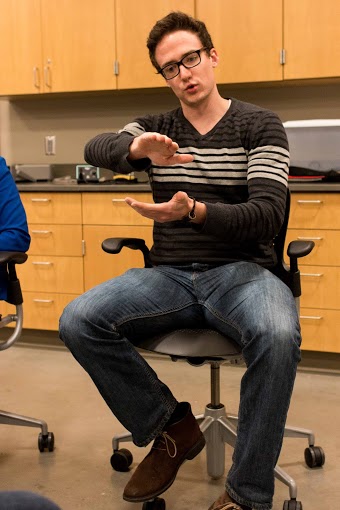
Imagine the whole floor moving under your feet. Is it an earthquake? Are you in space? Although you’re moving forward, the ground is rotating. It’s not a trip to the gym – you’re on the third floor of Engineering Hall on an atypical treadmill.
The six degrees of freedom treadmill, part of a pilot project in the Human Performance Lab, is used to study human balance. Biomedical engineering professor Brian Schmit runs it. The treadmill is used by Erika Zabre, a graduate student in the College of Engineering, and Jacob Van Dehy, a senior in the College of Engineering.
The treadmill is mounted on a motion base, similar to those used in flight simulators. It rotates and rolls under the walker’s feet to test balance capabilities, allowing them to experience complete flexibility of motion. The machine has been used by NASA in studies about human stability.
Zabre and Van Dehy hope to apply the pilot data in the future to studying people with balance issues. Subjects would include people recovering from strokes or suffering from multiple sclerosis.
“We think that this could provide a rehabilitation therapy that could really improve the quality of life,” Van Dehy said.
The HPL also has interest in studying prosthetics. Zabre and Van Dehy are experimenting with force plates and how prostheses can sense when to go into different modes to accommodate a user.
Many of the prostheses on the market today are operated manually.
“You have to, for example, hit the toe of the prostheses for it to go into stair mode,” Zabre said. “We are going to have force data exactly on the transitions so that we can trigger our prostheses (automatically).”
In addition, the lab’s team is looking into stability studies for amputees.
“For amputees, one of the main issues is going up and down a hill, so we’re going to have the motion base moving up and down, so we also want them to have a visual field of where they’re going,” Zabre said.
A large television that plays virtual reality programs is attached to the treadmill. With virtual reality in place, the team hopes this will create an improvement in biofeedback from participants.
Though the project has not partnered with any hospitals yet, Van Dehy and Zabre’s ultimate goal is to see their studies in action by helping those with balance issues and prostheses. For now, students in biomedical engineering have access to tools that could create solutions to medical issues related to balance and stability.
The treadmill has been a point of interest among students and visitors to Engineering Hall. Van Dehy and Zabre have conducted test runs with friends, colleagues and multiple sclerosis patients. Outreach programs, such as Girls Who Code, have inquired about visits as well.
“It’s a big hit on freshman orientation days,” Van Dehy said.

